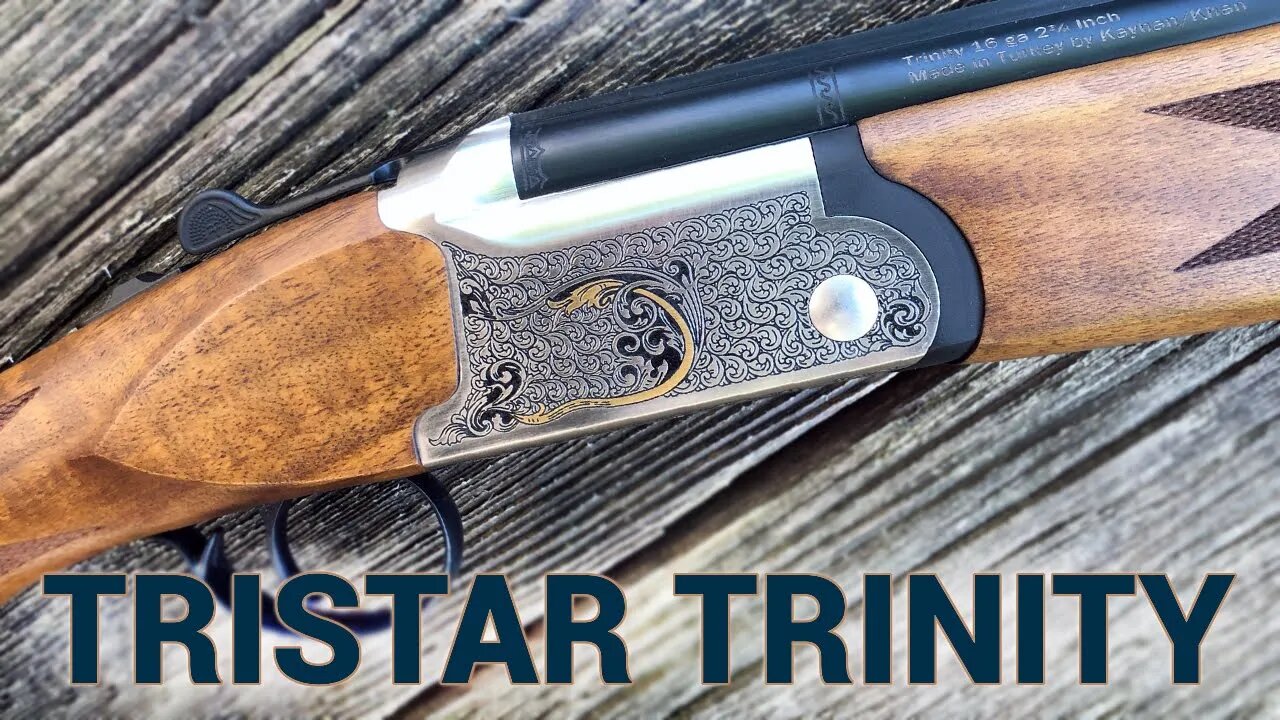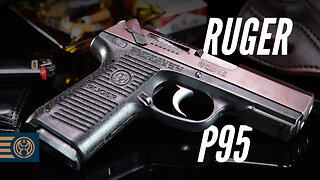Premium Only Content

Turkish Delight: TriStar Trinity Shotgun Review
Two traits that seldom converge on a single firearm are affordability and classy appearance, yet Tristar’s new family of Trinity over/under shotguns manages both. But does the gold-adorned double perform in the field as nicely as it looks in hand? Guns.com finds out.
With a tagline of “Reliable, Functional, and Hardworking,” the Tristar Trinity is engineered for serious use. The Trinity is built on a solid frame with sealed actions to keep out dirt and debris. Steel mono-block barrels are chrome-lined in both chamber and barrel. There are self-adjusting locking lugs, a single selective trigger, and dual extractors. The top tang barrel selector, like most other comparable designs, doubles as the safety. A red fiber optic front sight comes standard atop the ventilated rib.
There’s little doubt the Trinity is the finest looking hunting double ever put out by Tristar. The acid-etched receiver displays sweeping scrollwork with 24-karat gold inlay. Turkish Walnut stocks are finished with a sleek-looking oil finish.
Tristar’s Trinity launch includes five variants in 20-, 16-, and 12-gauge with 26- and 28-inch barrels. The Trinity ships with five Beretta/Benelli Mobil-style choke tubes (SK, IC, M, IM, F) in a hard-sided choke box.
The Turkish-made Trinity lines of shotguns are built at Kayhan/Khan with import and customer service headquarters stateside in Kansas City, Missouri. They are backed by a five-year mechanical warranty for the original purchaser.
Though it steals the show in looks, Tristar’s Trinity was not the only new launch for 2020. Tristar also debuted a budget-friendly O/U -- the Trinity LT. Unlike the steel Trinity, the LT version is a lightweight aluminum-alloy-framed double. Ditching the gold inlay and wearing semi-gloss stocks, the Trinity LT targets those who may want a lighter gun to tote afield.
Where the Trinity sticks with the bigger bores on the solid frame, the LT includes 410-bore and 28-gauge options along with the 12- and 20-gauges. Weights on the LT span 5.3- to 6.3-pounds in comparison to the heavier Trinity’s range of 6.3- to 6.9-pounds.
Our test shotgun came as a 28-inch barreled 16-gauge Trinity. Why did we choose the Trinity over the LT? For one, the 16-gauge is not available on the alloy LT; and two, the weight savings between steel and alloy build is not worth the trade-off for our purposes of half-day upland hunts and sporting clays outings. It must be noted, however, that for increased durability, the LT does use steel inserts at contact points inside the softer aluminum receiver.
Those who spend long days in the field may beg to differ, and that’s the beauty of having options. For comparison’s sake, when using the 12-gauge with 28-inch barrels, the Trinity weighs 6.8-pounds while the Trinity LT shaves some ounces to come in at 6.3-pounds.
The Trinity is striking not only because of its exceptional looks for the cost but also for its initial performance. At first feel, the O/U balances well with its steel construction, with our test 16-gauge weighing in at 6.7-pounds. A rubber recoil pad helps negate shoulder impact, though 16 is not a notoriously hard hitter on the back end.
The Trinity comes with dual extractors instead of ejectors. While many hunters, the author included, prefer ejectors when quicker reloads are desired, the extractors make hand removal of spent hulls easy enough. Pressed checkering on the Trinity is quite deep into the walnut and offers plenty of grip in the field, though it’s easy to ding the checkering with hard use. Our 16-gauge uses the common 2-3/4-inch chamber, while both the 20- and 12-gauge Trinity make use of a 3-inch chamber, well-suited for high brass hunting loads.
We fired a mix of factory 16-gauge rounds, including both target and hunting loads from Kent Cartridge, Federal, Rio, and Aguila, along with home-rolled reloads. For our purposes, the Trinity is a nice meeting point between an upland hunting double-barrel, a sporting clays companion, occasional trap shooter, and all-around do-all O/U.
Where we’ve had other budget-priced shotguns falter under hard use, the Trinity has kept on ticking out the rounds. How it will fare over the years, only time will tell, but initial indications are swell. While this is no Browning Superposed or, similarly, $1,000+ O/U, it’s not masquerading as such. There’s a wide market for affordable O/Us, and we have little doubt both the Trinity and Trinity LT will be the best sellers yet for Tristar.
There’s often a wide disconnect between value-priced shotguns and attractive ones, but in this case, the new O/U from Tristar checks both boxes. The Trinity—and lighter Trinity LT—are marketed as hunting guns but do double-duty as clay busters as well. With options in both standard and sub-gauges, the Trinity is poised to grab serious market share as a solid value purchase for experienced shooters and new shotgunners alike.
-
 6:32
6:32
Guns.com
8 days ago $0.53 earnedRuger P95: This Forgotten Wonder Nine is Worth Remembering
4914 -
 1:03:57
1:03:57
Sarah Westall
5 hours agoMara Lago Accord Joins the Fed, Fed Waves the White Flag & more w/ Andy Schectman
17.2K -
 2:44:12
2:44:12
I_Came_With_Fire_Podcast
1 day ago*BREAKING* Special Guest Katarina Szulc
24.5K2 -
 3:22:20
3:22:20
megimu32
5 hours agoOFF THE SUBJECT: FAFO Friday! Bodycams & Mario Kart Mayhem!
16.8K4 -
 55:36
55:36
Flyover Conservatives
1 day ago4 Strategies to Create Opportunity from Nothing - Clay Clark | FOC Show
23.7K -
 1:49
1:49
Gaming on Rumble
10 hours agoWhat is the Rumble Creator Program!?!? (Active Premium Creators) | Lvl UP
25.2K2 -
 5:56:26
5:56:26
Midnight In The Mountains
7 hours agoGaming w/ PER·SE·VER·ANCE | Midnights Play Fortnite | Split Screen Action!
16.5K2 -
 3:56:17
3:56:17
Nerdrotic
9 hours ago $13.54 earnedLet's TACO-bout Take Us North, Hollywood COPE! Cracker Barrel CRACKED! | Friday Night Tights 369
93.6K5 -
 1:16:30
1:16:30
RiftTV
8 hours agoHow Blue Light is Turning You Gay | The Rift | Guest: Jack Kruse
31.5K10 -
 LIVE
LIVE
Eternal_Spartan
14 hours ago🟢 Eternal Spartan Plays Final Fantasy 7 Remake Intergrade | USMC Vet | Join the Best Chat on Rumble
82 watching